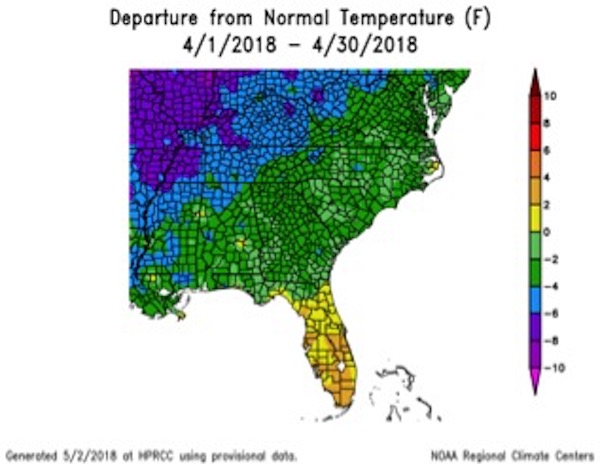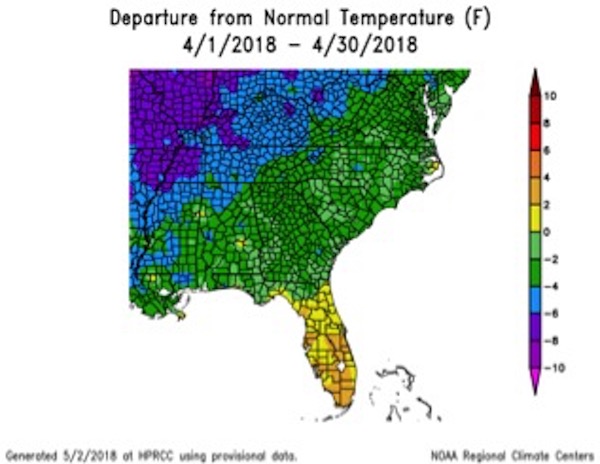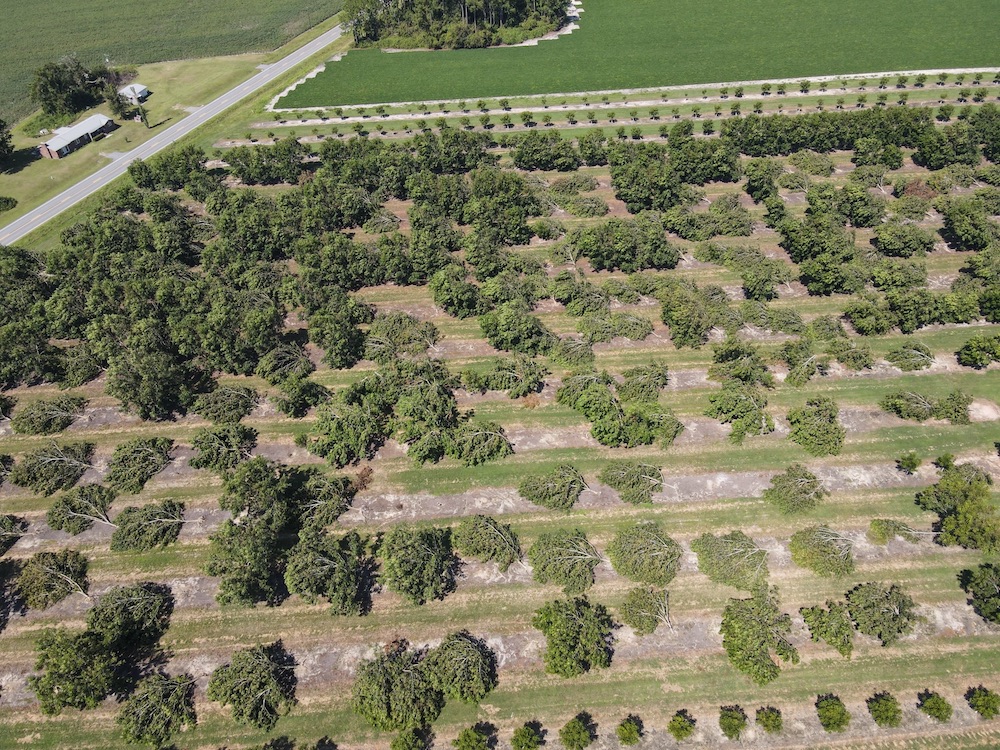Going into the start of the growing season, a wetter, cooler-than-normal April helped to reduce drought conditions across the northern three-quarters of Georgia, but drought conditions remain in the southeastern corner of the state.
When soil conditions permitted, farmers were busy planting and completing other field work in April, but cool conditions slowed crop growth in some areas.
Ample rainfall enhanced soil moisture and encouraged the growth of crops and pastures, but precipitation caused problems for tobacco transplanting and the onion harvest. The rain also fueled diseases and affected watermelons and small grains. Windy conditions throughout the month created problems for pesticide and herbicide application and caused wheat and oats to lodge, or fall over.
Last month, temperatures were as many as 2.9 degrees Fahrenheit below average in some parts of the state.
- In Albany, Georgia, the monthly average was 64.3 F, 1.9 degrees below normal.
- In Alma, Georgia, the monthly average was 64.8 F, 1.4 degrees below normal.
- In Athens, Georgia, the monthly average was 58.8 F, 2.9 degrees below normal.
- In Atlanta, the monthly average temperature was 59.8 F, 2.2 degrees below normal.
- In Augusta, Georgia, the monthly average was 60.6 F, 2.1 degrees below normal.
- In Brunswick, Georgia, the monthly average was 68.4 F, 0.1 of a degree below normal.
- In Columbus, Georgia, the monthly average was 63.3 F, 1.3 degrees below normal.
- In Macon, Georgia, the monthly average was 61.2 F, 2.2 degrees below normal.
- In Savannah, Georgia, the monthly average was 64.2 F, 1.4 degrees below normal.
- In Rome, Georgia, the monthly average was 58 F, 1.8 degrees below normal.
- In Valdosta, Georgia, the monthly average was 64.4 F, 1.5 degrees below normal.
The outlook for May, and for the period from May through July, shows enhanced chances for above-normal temperatures.
For most of the state, precipitation was above normal in April.
The highest monthly total precipitation recorded by a National Weather Service station was 6.53 inches in Atlanta, 3.17 inches above normal. The lowest was in Alma, where the station recorded 2.02 inches, 0.79 of an inch below normal.
- Albany received 3.90 inches, 0.26 of an inch above normal.
- Athens received 5.49 inches, 2.34 inches above normal.
- Augusta received 3.47 inches, 0.63 of an inch below normal.
- Brunswick received 4.16 inches, 1.67 inches below normal.
- Columbus received 5.02 inches, 1.47 inches above normal.
- Macon received 4.99 inches, 2.03 inches above normal.
- Savannah received 4.33 inches, 1.26 inches above normal.
- Rome received 4.50 inches, 0.45 of an inch above normal.
- Valdosta received 5.24 inches, 2.37 inches above normal.
One daily precipitation record was set this month. On April 23, 4.16 inches of rain fell in Atlanta, surpassing the old record of 2.40 inches set back in 1883.
Last month’s highest daily rainfall total reported by Community Collaborative Rain, Hail and Snow Network (CoCoRaHS) volunteers, 5 inches, was recorded west of LaFayette, Georgia, in Walker County on April 23. An observer near Townsend, Georgia, in McIntosh County recorded 3.77 inches on April 24, and a volunteer in Dillard, Georgia, in Rabun County recorded 3.54 inches on the same date.
The highest monthly precipitation amount was 10.44 inches, recorded by an observer near Dillard, followed by 10.01 inches recorded by the LaFayette observer, and 9.10 inches recorded near Trenton, Georgia, in Dade County.
The police chief of Laurens County, Georgia, reported a tornado on April 7, and two additional tornadoes were reported on April 15 in Decatur County in southwestern Georgia and in Camden County along the Georgia coast. A CoCoRaHS observer reported hail in Lumpkin County, Georgia, on April 27.
Drought conditions gradually eroded over the month as plentiful rains covered most of the state. By the end of April, the area of severe drought in the southeastern part of the state decreased and many other parts of the state saw the drought eliminated altogether.
The northern part of the state will continue to have a greater chance of above-normal precipitation in May. There are equal chances of above-, near- or below-normal precipitation from May through July. Drought is expected to persist in southeastern Georgia through May.
For more information, please see the Climate and Agriculture in the South East blog at site.extension.uga.edu/climate/, the Facebook page at SEAgClimate and the Twitter page at @SE_AgClimate. Please email your weather and climate impacts on agriculture to pknox@uga.edu.








